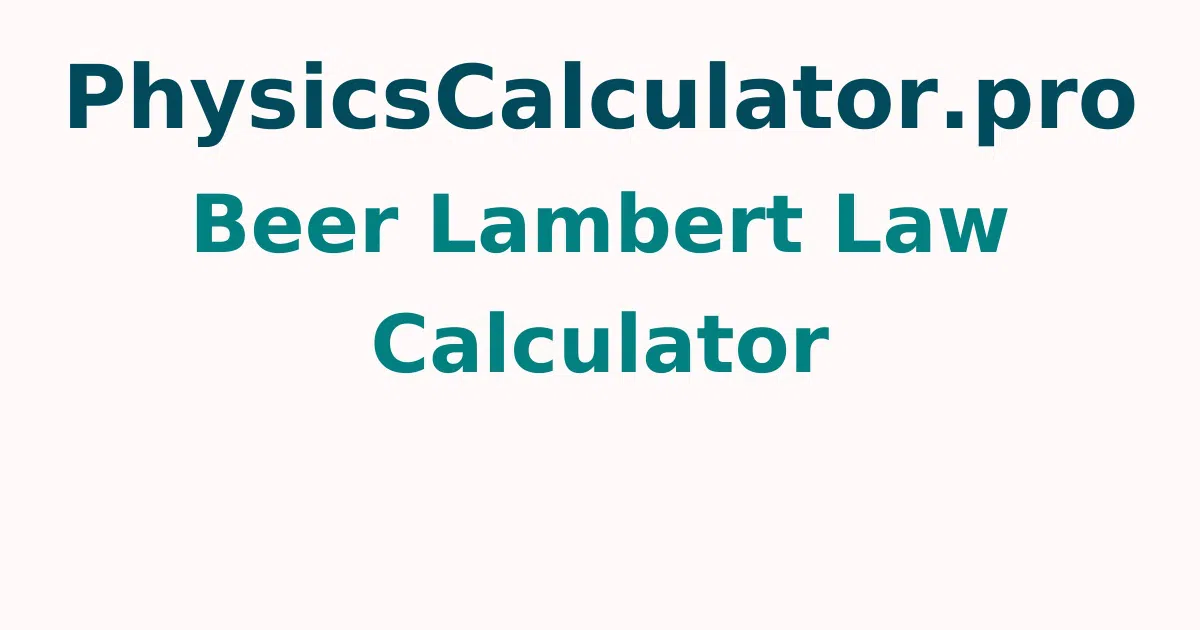Beer Lambert Law Calculator
Beer-Lambert law calculator developed by us allows the user to calculate the absorbance (or attenuation) of light as it passes through any material in the direction of propogation. You can also use this calculator to determine the molar concentration of solutions with the one mole already taken into relative consideration.
What is Beer's Law (Beer-Lambert Law)?
Beer-Lambert Law is also known as Beer's law or Beer-Lambert–Bouguer law. It gives a relationship between the concentration of a solution and the attenuation of light as it passes through the solution in the direction of propogation of the light passing through the solution.
Beer's law states that when a beam of electromagnetic radiation passes through a sample (usually a solution), its absorbance depends on the concentration of the sample calculated in mole per litre and the path length of the beam in the sample.
Beer's Law Equation
To understand absorbance, let a light beam of intensity passes through a solution placed in a container of diameter l. If the solution absorbs light, the intensity of the light emerging from the container will be less than Io. If the intensity of the transmitted light is I, we can define absorbance A of the concentrated solution as A = log10(Io / I)
We can express the Beer's law equation as: A = log10(Io / I) = ε * l * c
- where ε — Molar absorption coefficient or the molar absorptivity;
- l — Path length of the beam in the sample; and
- c — Concentration of the solution.
In spectroscopy method of calculation, the path length is usually expressed in cm and absorbance is unitless.The unit for expressing the concentration of sample by the passing of light with same intensity in the solution is mol/L, and hence the units of molar absorptivity are L/mol•cm.
Absorbance to Transmittance Conversion
The fraction of light that passes through the sample gives the transmittance T, i.e. T = I / Io
…and we can express the relation between transmittance and absorbance as A = log10(1 / T). It should be well noted that the relation between absorbance and transmittance is logarithmic. An absorbance of 0 implies a transmittance of 100%.
In such spectrophotometry techniques, the intensity of the radiation entering the sample solution and the intensity of radiation coming out of it is measured by the calculations.
What is Absorbance?
When light travels through any medium that has particles, it gets attenuated. In other words, as light passes through molecules and atoms of a medium, its energy keeps diminishing by the time it reaches the receiving end through the tunnel of concentrated solution. This energy that the light beam loses is transferred to the particles of the medium. They get excited with this change in energy and display the excitement in the form of temperature rise or color emission in the solution. For instance pink, brown and yellow in kcl, mno4, and ferrous solutions.
What is Transmittance?
Transmittance is the property of a medium that is opposite to absorbance. While absorbance indicates the amount of light energy absorbed by the medium, transmittance explains how much light is transmitted to the other end.
The formula to calculate the transmittance of a medium is given by: T = I/I0.
It is common to express transmittance in percentage. Thus, percentage transmittance = T% = 100 * (I/I0)
Applications of the Beer-Lambert law
Generally, the widely used spectroscopic analysis techniques in chemistry are based on the Beer-Lambert law. Some common applications of Beer's law in analytical chemistry are:
- To determine the concentration of samples by measuring the absorbance and transmittance of the solution.
- To determine the identity of an unknown substance by determining its molar absorptivity in the concentrated solution.
FAQs on Beer-Lambert law Calculator
1. What is the unit of absorbance in Beer's law?
The absorbance is a unitless quantity. It is the ratio of the intensity of the incident light and the transmitted light. It is unitless.
2. How do you find concentration from absorbance?
The Absorbance in solution is directly proportional to concentration and length: A = εcl. ε is the wavelength-dependent molar absorbtivity coefficient and it is constant for a particular substance.
3. How do you calculate absorptivity?
The standard equation for absorbance is A = ɛ x l x c, where A is the amount of light absorbed by the sample for a given wavelength, ɛ is the molar absorptivity, l is the distance that the light travels through the solution, and c is the concentration of the absorbing species per unit volume.
4. What is a slope in Beer's Law?
Absorbance values can be used to determine the concentration of a chemical in a solution using the Beer-Lambert Law.
5. How do I calculate the concentration of a solution?
Divide the mass of the solute by the total volume of the solution and hence find the molarity and concentration of the solution.
